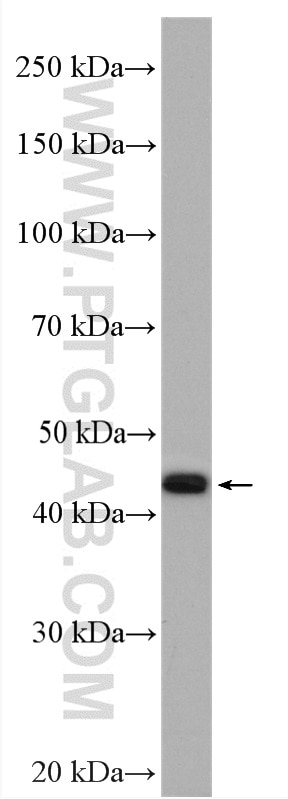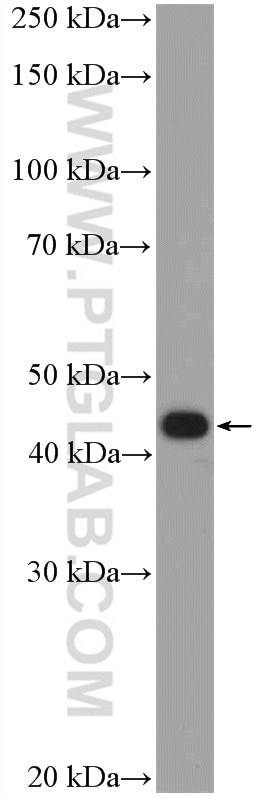Anticorps Polyclonal de lapin anti-PDX1
PDX1 Polyclonal Antibody for WB, ELISA
Hôte / Isotype
Lapin / IgG
Réactivité testée
Humain, souris et plus (1)
Applications
WB, IF, IHC, ELISA
Conjugaison
Non conjugué
N° de cat : 20989-1-AP
Synonymes
Galerie de données de validation
Applications testées
| Résultats positifs en WB | cellules PC-3, cellules BxPC-3 |
Dilution recommandée
| Application | Dilution |
|---|---|
| Western Blot (WB) | WB : 1:500-1:1000 |
| It is recommended that this reagent should be titrated in each testing system to obtain optimal results. | |
| Sample-dependent, check data in validation data gallery | |
Applications publiées
| WB | See 10 publications below |
| IHC | See 1 publications below |
| IF | See 6 publications below |
Informations sur le produit
20989-1-AP cible PDX1 dans les applications de WB, IF, IHC, ELISA et montre une réactivité avec des échantillons Humain, souris
| Réactivité | Humain, souris |
| Réactivité citée | rat, Humain, souris |
| Hôte / Isotype | Lapin / IgG |
| Clonalité | Polyclonal |
| Type | Anticorps |
| Immunogène | Peptide |
| Nom complet | pancreatic and duodenal homeobox 1 |
| Masse moléculaire calculée | 31 kDa |
| Poids moléculaire observé | 40-50 kDa |
| Numéro d’acquisition GenBank | NM_000209 |
| Symbole du gène | PDX1 |
| Identification du gène (NCBI) | 3651 |
| Conjugaison | Non conjugué |
| Forme | Liquide |
| Méthode de purification | Purification par affinité contre l'antigène |
| Tampon de stockage | PBS avec azoture de sodium à 0,02 % et glycérol à 50 % pH 7,3 |
| Conditions de stockage | Stocker à -20°C. Stable pendant un an après l'expédition. L'aliquotage n'est pas nécessaire pour le stockage à -20oC Les 20ul contiennent 0,1% de BSA. |
Informations générales
Pancreatic duodenal homeobox-1 protein (PDX-1), also designated INS promoter factor (IPF1), INS upstream factor 1 (IUF1), somatostatin trans-activating factor-1 (STF-1) and glucose-sensitive factor (GSF), is a 282 amino acid homeodomain-containing transcription factor present in pancreatic beta-cells. PDX-1 is a key regulator of pancreatic islet development and INS gene transcription in beta-cells. PDX-1 is expressed in all cells at the early stages of development and is mainly restricted to the pancreas and duodenum in adult. HNF-3b, HNF-1a and SP1 positively regulate the PDX-1 enhancer element. PDX-1 is also regulated by glucagon-like peptide through activation of adenylyl cyclase, which results in an increase in intracellular cAMP activity. The increased levels of cAMP, and the resulting activation of PKA, lead to an increase in PDX-1 transcription and translocation of the protein to the nuclei of beta-cells. PDX-1 binds to the sequence C(C/T) and can heterodimerize with PBX. PDX-1 is phosphorylated by the SAPK2 pathway under high glucose concentrations. Mutations in the PDX-1 gene can cause maturity-onset diabetes of the young and pancreatic agenesis.
Protocole
| Product Specific Protocols | |
|---|---|
| WB protocol for PDX1 antibody 20989-1-AP | Download protocol |
| Standard Protocols | |
|---|---|
| Click here to view our Standard Protocols |
Publications
| Species | Application | Title |
|---|---|---|
ACS Appl Mater Interfaces Targeted Polymeric Nanoparticles Based on Mangiferin for Enhanced Protection of Pancreatic β-Cells and Type 1 Diabetes Mellitus Efficacy. | ||
Biomaterials Three-dimensional cell-culture platform based on hydrogel with tunable microenvironmental properties to improve insulin-secreting function of MIN6 cells. | ||
Biofabrication Dual-core coaxial bioprinting of double-channel constructs with a potential for perfusion and interaction of cells. | ||
J Mol Cell Biol Human umbilical cord-derived mesenchymal stem cells alleviate oxidative stress-induced islet impairment via the Nrf2/HO-1 axis | ||
J Biol Chem Tectorigenin enhances PDX1 expression and protects pancreatic β-cells by activating ERK and reducing ER stress. | ||



